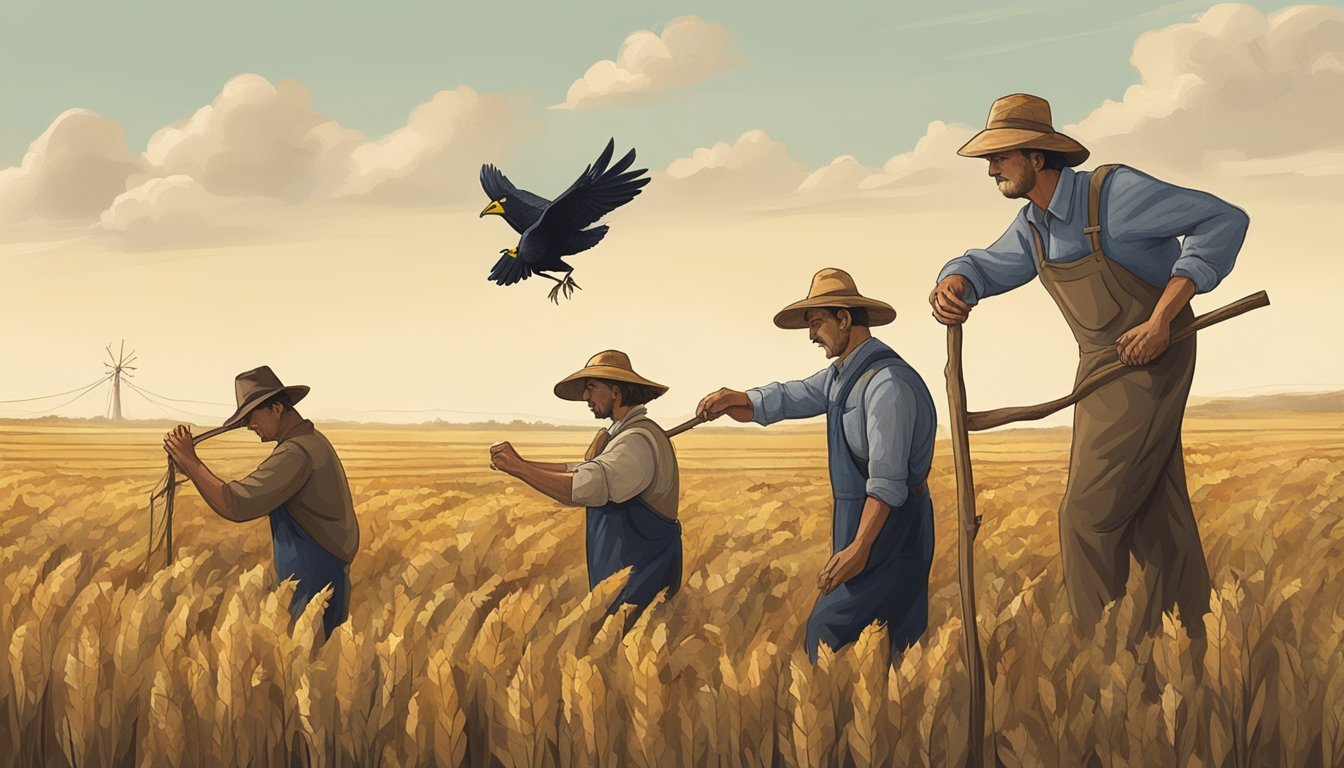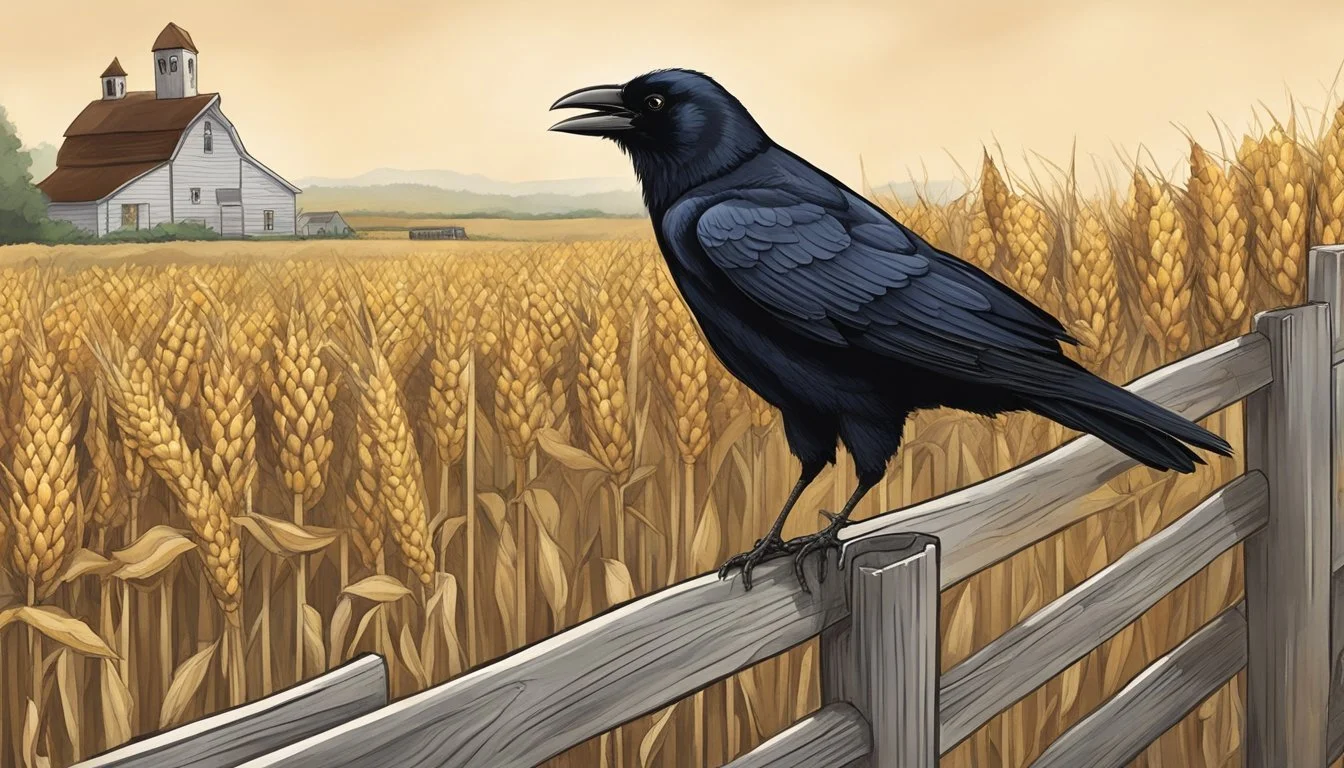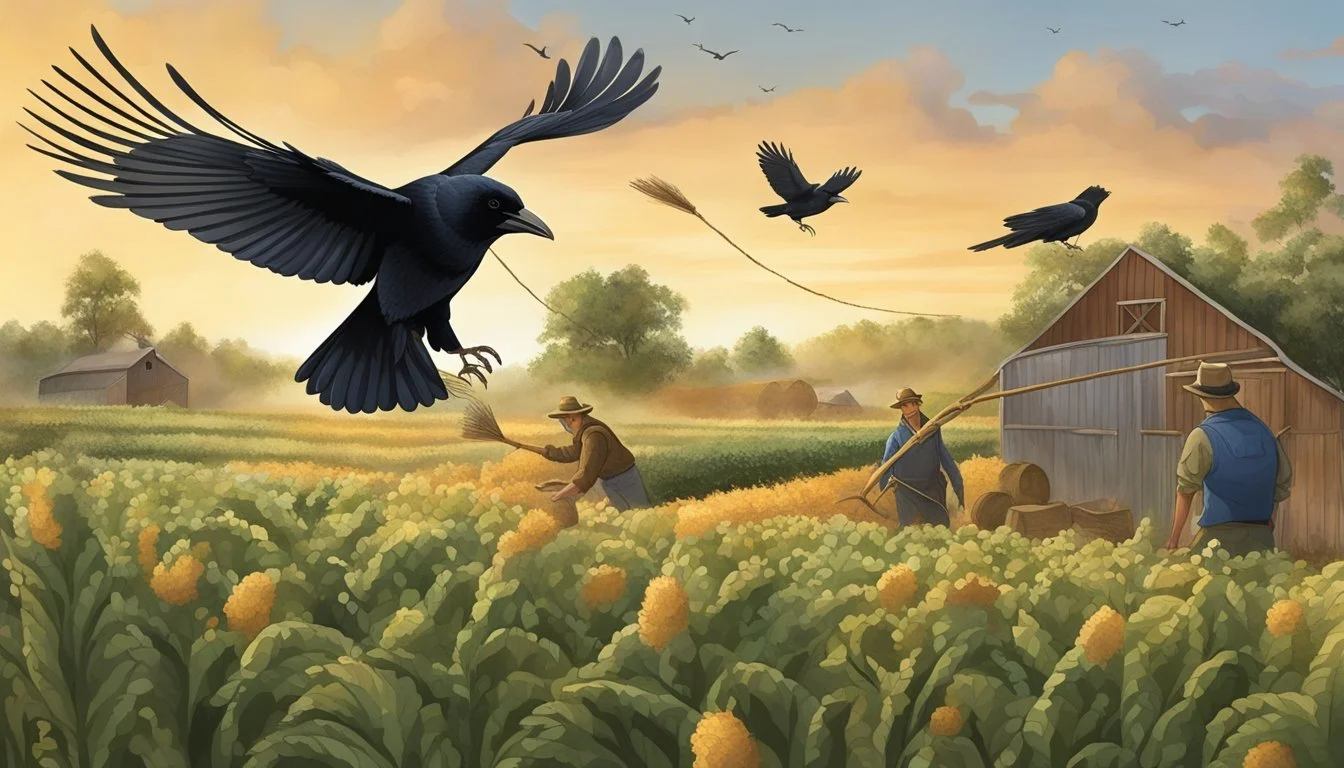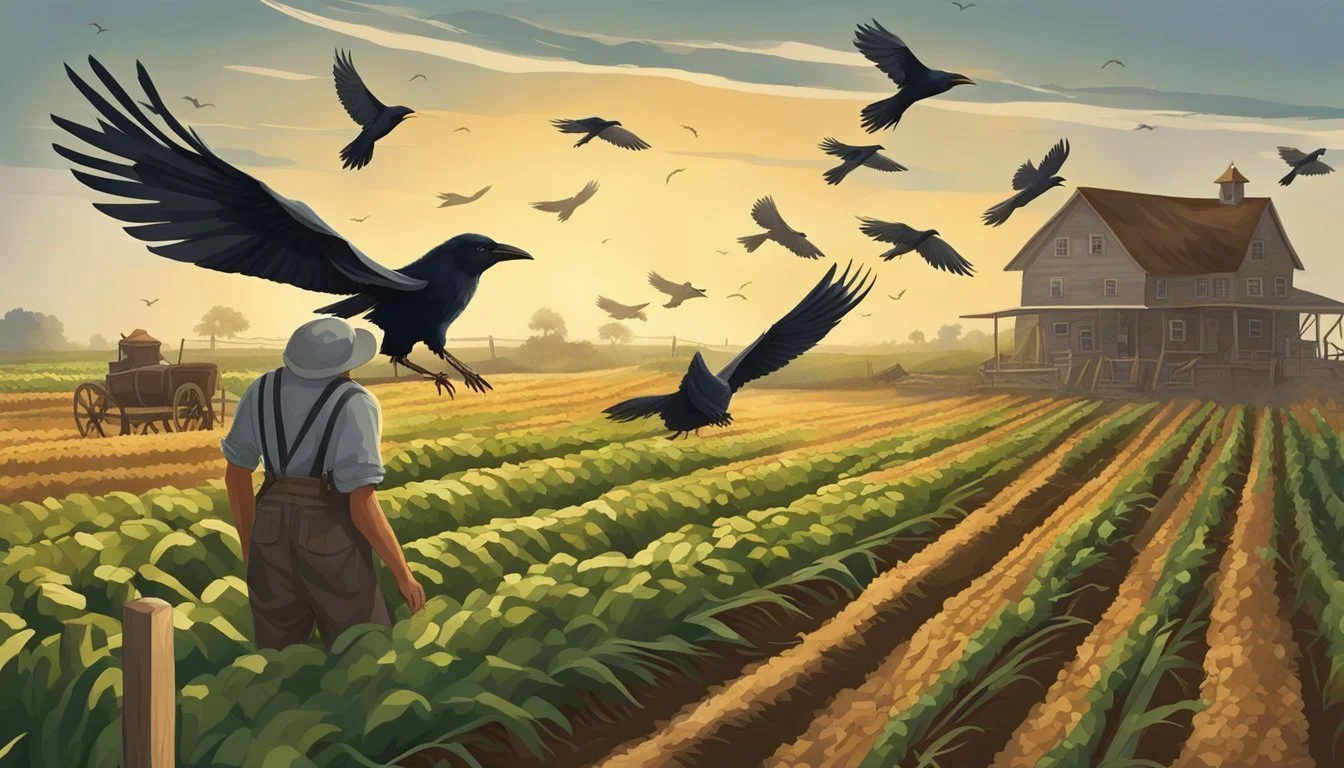Protecting Crops from American Crow
Effective Strategies for Farmers
American crows, or Corvus brachyrhynchos, are highly intelligent birds known for their adaptable and opportunistic behavior. While they play a crucial role in the ecosystem by controlling pest populations and cleaning up carrion, their presence can sometimes become problematic for farmers and gardeners. When crows turn their attention to agricultural areas, they have the potential to cause significant damage to crops, making it imperative for those in agriculture to employ effective management strategies.
Given the importance of conservation and maintaining ecological balance, controlling crow populations in a humane and ethical manner is vital. It is not about eliminating these birds, but rather mitigating their impact on agriculture. There are a variety of methods that can be used to protect crops from crows, ranging from exclusion tactics to habitat modification. Understanding the behavior of the American crow is the first step in devising a management plan that minimizes damage to agriculture while respecting the birds' role in the environment.
American Crow Identification
Identifying the American Crow is key to understanding how to protect crops effectively, as their physical appearance, habitat preferences, and behaviors are essential for accurate recognition and subsequent control measures.
Physical Characteristics
The American Crow (Corvus brachyrhynchos) is a prevalent bird across North America known for its all-black plumage. It features a strong, black beak and rectangular tail. Adult crows exhibit a wingspan ranging from 33 to 39 inches (84 to 99 cm), placing them among the larger bird species within their range. Their size can be as large as 17-21 inches (43-53 cm) in length. In sunlight, their feathers can have a purple and blue sheen.
Habitat and Range
American Crows are adaptable birds, thriving in various habitats including urban areas, forests, and open fields. They are commonly found throughout North America, from Canada to the United States, extending their range to the West where they often overlap with the Northwestern Crow. These intelligent birds have a widespread population, highly capable of adjusting to different environments.
Behavioral Traits
As social creatures, American Crows are often observed in groups. They are known for their distinctive call, a hoarse, cawing voice that is easily recognized. Intelligent and adaptable, crows display various behaviors that aid in their survival and success in diverse environments. They forage on the ground and are known for their problem-solving skills, which can sometimes make them a challenge for farmers attempting to protect their crops.
Diet and Feeding Habits
The American crow is an omnivorous bird, employing a wide range of feeding techniques to consume a varied diet. This diversity in consumption and the intelligence with which they obtain food can pose challenges for crop protection.
Feeding Techniques
Crows exhibit advanced foraging behaviors that showcase their intelligence. They are known to use tools to access food and have been observed dropping nuts onto roads to crack them open with passing vehicles. Their hunting tactics are versatile, ranging from solitary to group foraging in order to maximize their chances of finding food sources.
Common Food Sources
American crows have a diet comprising mostly of:
Nuts and seeds: These include corn, peanuts, and various wild seeds.
Fruits: They consume fruits such as grapes and cherries, which they often find in agricultural areas.
Insects and earthworms: During certain seasons, these make up a significant portion of their diet.
Carrion: As opportunistic feeders, crows scavenge for carrion.
Small animals: Occasionally, crows will prey on small animals, including nestlings of other birds.
Their diverse dietary requirements can lead them to be an agricultural pest.
Human Influence on Diet
Human-modified landscapes have altered crow diets significantly. Easily accessible garbage dumps, and garbage itself, provide crows with ample food resources, contributing to their successful adaptation in urban environments. Over time, this has led to increased populations in these areas where they can be found scavenging for human food waste, which often includes remnants of agricultural produce. Crows may also frequent bird feeders, taking advantage of the supplied seeds and nuts.
Reproduction and Life Cycle
Understanding the reproduction and life cycle of the American crow is essential for implementing measures to protect crops effectively. Precise knowledge of their nesting habits, the development of young crows, and family dynamics can aid farmers in targeting the right times and methods for crop protection.
Nesting Habits
The nesting season of American crows typically starts from February to May in the north and earlier in the south. They select a nest site that is usually high off the ground in tall trees to avoid predators. The construction of the nest is a joint effort, with both male and female crows collecting sticks and lining the inner cup with pine needles, weeds, and soft materials.
Development of Young
American crows lay a clutch of about 3-6 pale bluish-green eggs, marked with brown and gray. The incubation, which predominantly the female undertakes, lasts about 18 days. After hatching, the nestlings require extensive care and feeding, which lasts around 35 days until they are capable of fledging. During this period, both parents are actively involved in provisioning.
Family Dynamics
Crows often exhibit cooperative breeding behavior. This means that in addition to the breeding pair, there may be additional family members, usually offspring from a previous brood, helping to raise the young. These groups can be quite complex, with members participating in the defense of the nest as well as in the feeding and care of the nestlings. Such social structures are advantageous for the survival of the young crows and should be considered when developing strategies to deter crows from crops.
Threats and Conservation
The American Crow, though a resilient and intelligent bird, faces numerous challenges that range from conflicts with agricultural practices to diseases such as West Nile Virus. These issues require a balance of legal protection and targeted conservation efforts.
Human-Wildlife Conflict
The American Crow is often seen as a pest in agricultural settings due to their feeding habits, which can lead to significant crop damage. Manicured lawns, athletic fields, cemeteries, and parking lots in urban areas like city parks also provide habitat for crows, leading to a conflict of interest with humans.
Disease and Predation
Crows are susceptible to diseases, notably the West Nile Virus, which have caused declines in certain populations. They are also predated by animals, such as cats, and can be affected by environmental changes and human activities.
Legal Protection
Protected under the Migratory Bird Treaty Act, the American Crow benefits from regulations intended to safeguard migratory bird populations. However, these birds are sometimes included in control permits, especially when deemed an agricultural nuisance.
Conservation Efforts
Organizations like the American Bird Conservancy engage in conservation efforts to ensure the species does not become a threatened species. These efforts focus on habitat preservation, public education, and research into crow adaptability and conservation strategies.
The American Crow's adaptability has allowed it to thrive in many environments, yet the balance with human interests and conservation continues to be a delicate one.
Crop Protection Strategies
Effective crop protection strategies are critical for farmers to minimize losses caused by American crows, known for their intelligence and adaptability. These birds can cause significant damage to a range of crops, necessitating a multilayered approach to deterrence and management.
Agricultural Practices
Farmers can adopt several agricultural practices to safeguard their fields. Crop rotation disrupts the crows' feeding pattern, making it less likely for them to return to the same fields. Timely harvesting of crops ensures that crows have a shorter window to cause damage. Moreover, planting cover crops can reduce the visibility and access to the soil for crows looking for food.
Deterring Crows
Deterring crows effectively requires a combination of methods due to their intelligent nature. Visual deterrents include reflective tapes, decoy predators, or scarecrows, which create an inhospitable environment. Auditory deterrents such as distress calls or loud noises can also be used to scare crows away from crops. For more persistent issues, physical barriers like netting can provide a direct method of excluding crows from high-value crops, as suggested by the Internet Center for Wildlife Damage Management.
Coexistence and Management
Coexistence and management involve understanding the crows' diet, nesting patterns, and the role they play in the ecosystem. Non-lethal management techniques, including habitat modification, can make an area less attractive to crows without harming them. This aligns with conservation efforts and encourages biodiversity in agricultural areas. Moreover, implementing integrated pest management (IPM) programs can reduce the need for pesticides, creating a more sustainable balance between crop production and wildlife.
Interaction With Other Species
The American Crow, a member of the Corvidae family, engages in intricate ecological relationships with various species, decreed by competition, its role in the ecosystem, and its contribution to ornithological studies.
Competitors
American Crows encounter competition for food and habitat from similar birds within the Corvidae family, such as Common Ravens, Blue Jays, and Magpies. They often vie for the same resources, given that many corvids have an omnivorous diet and demonstrate intelligent foraging behaviors. In agricultural regions, these birds can be seen contesting for corn and other crops.
Role In Ecosystem
As opportunistic feeders, American Crows play a vital role in the ecosystem. They scavenge and help to maintain the environment by consuming carrion and waste. As both predators and prey, their interactions with other species can directly influence ecological balance. For instance, they may impact populations of smaller birds and rodents, while larger raptors may prey upon the crows themselves.
Birdwatching and Study
The American Crow provides substantial opportunity for birdwatching and scientific study. Institutions like the Cornell Lab of Ornithology and databases such as Avibase offer ornithologists and enthusiasts insights into the complex behaviors of crows and other passerine birds within the order of Passeriformes. Through study, researchers understand more about interspecies interactions and the overall health of ecosystems.
Frequently Asked Questions
American crows are highly intelligent birds that can cause significant damage to agricultural fields. Effective management requires understanding the most effective deterrent methods and the ecological implications of these birds.
What methods are effective for deterring American crows from agricultural fields?
Australian crow traps are considered effective for capturing crows, especially during winter when food is scarce. These traps should be sizeable and may have panels for easy transport and storage.
Can homemade remedies be used to repel crows from crops, and how are they prepared?
Homemade remedies like reflective objects or scarecrows can sometimes be used to repel crows. Preparing these involves using shiny materials or building a scarecrow figure that mimics a human presence.
What non-lethal measures can farmers implement to safeguard crops against crow damage?
Farmers can employ non-lethal strategies such as exclusion nets or covering ripening corn with paper to prevent crows from accessing and damaging crops.
Which sounds or visual deterrents can prevent crow invasions in crop areas without harming other bird species?
Employing a range of auditory and visual deterrents, like recorded distress calls or hawk silhouettes, can be effective. It's important to select deterrents that target crows specifically and minimize impact on other bird species.
How can compost areas be protected from crows to prevent them from feeding on organic waste?
Compost areas can be protected by using sturdy covers or enclosed compost bins. This prevents crows from accessing and scattering organic material.
What is the ecological significance of crows, and why is it important to consider this when managing their populations?
Crows play an important role as scavengers and seed dispersers in their ecosystems. Effective population management should consider the ecological significance of crows, ensuring that control methods do not jeopardize their role in nature.






